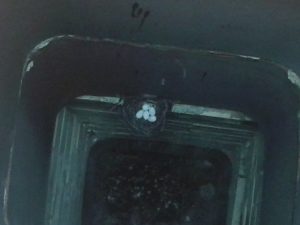Noises in the Chimney: Swifts
As a nuisance animal removal company, we often get called to investigate animal noises in and around fireplaces and chimneys.
Clients who hear noises want to know, “What’s in there? And can you get it out?”
While we remove wayward squirrels on occasion and families of raccoons living in chimneys every Spring, the noises that come from the chimney this time of year often come as a result of a super interesting bird called a chimney swift.
It’s been a few years since we profiled the swift. But since Ryan was on an investigation last week and was able to snap a cool picture of the nest with eggs in it, we thought it a fitting time to revisit chimney swifts.
Not Bat Sounds
A typical investigation for us starts with a client hearing a high pitched chitterring in the chimney.
This leads many wondering if they have bats living in the chimney.
Bats do create high pitched clicking (click-click-click-click) and can be vocal on roost, especially just before going out for the night. And, maternity colonies with pups this time of year are prone to be more noisy as there is communication between pup and mother.
But, if it is coming from an actual chimney and can be heard often, especially during daylight hours, it is most likely coming from swifts.
 To hear what swifts sound like, the Cornell Laboratory of Ornithology has a button to click on to hear swift at this page.
To hear what swifts sound like, the Cornell Laboratory of Ornithology has a button to click on to hear swift at this page.
Swifts prefer open, uncapped chimneys like this one. As the above picture shows, the nest is often placed quite a ways down the chimney.
This close up shows the nest with five eggs in it projecting outward from the side of the chimney. As you can see, they’ve adapted well to human development finding a good substitute for the natural site- a hollow tree.
Once the eggs are hatched, the noises will typically increase. But, the noises won’t last for long. In less than a month, the chicks will be able to fly and leave the nest.
Once they fledge, they’ll join other swifts in doing what they do best; eating insects.
One of the cool things about chimney swifts is that, like bats, they are voracious insect eaters and very positive for our local ecology.
Advice to Homeowners with Chimney Swifts
When we are called to investigate and find chimney swifts present, here is what we tell homeowners:
- These are valuable birds because of their insect eating.
- Federal Law protects them. It is illegal to kill them or move their nests or otherwise molest them.
- The problem won’t last more than a month; try to be patient.
- They will not harm the chimney
- You can prevent their future nesting (next year) with a chimney cap
Once a positive identification of chimney swifts is made, it is a good time to learn even more about swifts.
Some excellent resources we recommend are:
- the page of the Chimney Swift Conservation Organization
- the article What Just Zipped Into My Chimney by the Columbus, OH Audubon Society
These two resources are super informative in all aspects of chimney swift life history and conservation.
Help with Chimney/Fireplace Noises Akron, Canton, Kent, OH
If you’re having noises from the chimney or fireplace and would like some help investigating or formulating an action plan, give us a call.


